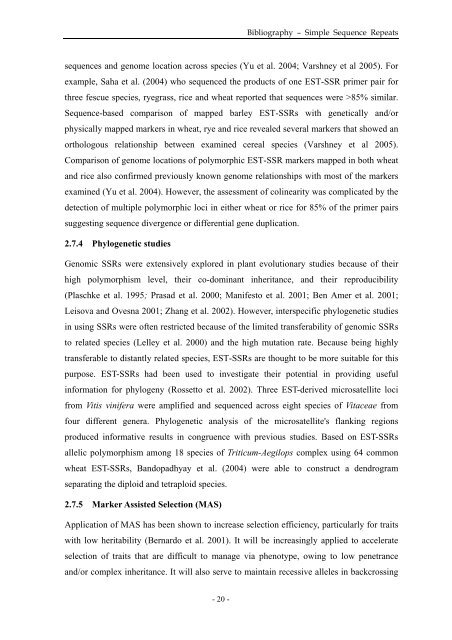Etude de la portabilité de marqueurs microsatellites issus d'EST de ...
Etude de la portabilité de marqueurs microsatellites issus d'EST de ...
Etude de la portabilité de marqueurs microsatellites issus d'EST de ...
You also want an ePaper? Increase the reach of your titles
YUMPU automatically turns print PDFs into web optimized ePapers that Google loves.
- 20 -<br />
Bibliography – Simple Sequence Repeats<br />
sequences and genome location across species (Yu et al. 2004; Varshney et al 2005). For<br />
example, Saha et al. (2004) who sequenced the products of one EST-SSR primer pair for<br />
three fescue species, ryegrass, rice and wheat reported that sequences were >85% simi<strong>la</strong>r.<br />
Sequence-based comparison of mapped barley EST-SSRs with genetically and/or<br />
physically mapped markers in wheat, rye and rice revealed several markers that showed an<br />
orthologous re<strong>la</strong>tionship between examined cereal species (Varshney et al 2005).<br />
Comparison of genome locations of polymorphic EST-SSR markers mapped in both wheat<br />
and rice also confirmed previously known genome re<strong>la</strong>tionships with most of the markers<br />
examined (Yu et al. 2004). However, the assessment of colinearity was complicated by the<br />
<strong>de</strong>tection of multiple polymorphic loci in either wheat or rice for 85% of the primer pairs<br />
suggesting sequence divergence or differential gene duplication.<br />
2.7.4 Phylogenetic studies<br />
Genomic SSRs were extensively explored in p<strong>la</strong>nt evolutionary studies because of their<br />
high polymorphism level, their co-dominant inheritance, and their reproducibility<br />
(P<strong>la</strong>schke et al. 1995; Prasad et al. 2000; Manifesto et al. 2001; Ben Amer et al. 2001;<br />
Leisova and Ovesna 2001; Zhang et al. 2002). However, interspecific phylogenetic studies<br />
in using SSRs were often restricted because of the limited transferability of genomic SSRs<br />
to re<strong>la</strong>ted species (Lelley et al. 2000) and the high mutation rate. Because being highly<br />
transferable to distantly re<strong>la</strong>ted species, EST-SSRs are thought to be more suitable for this<br />
purpose. EST-SSRs had been used to investigate their potential in providing useful<br />
information for phylogeny (Rossetto et al. 2002). Three EST-<strong>de</strong>rived microsatellite loci<br />
from Vitis vinifera were amplified and sequenced across eight species of Vitaceae from<br />
four different genera. Phylogenetic analysis of the microsatellite's f<strong>la</strong>nking regions<br />
produced informative results in congruence with previous studies. Based on EST-SSRs<br />
allelic polymorphism among 18 species of Triticum-Aegilops complex using 64 common<br />
wheat EST-SSRs, Bandopadhyay et al. (2004) were able to construct a <strong>de</strong>ndrogram<br />
separating the diploid and tetraploid species.<br />
2.7.5 Marker Assisted Selection (MAS)<br />
Application of MAS has been shown to increase selection efficiency, particu<strong>la</strong>rly for traits<br />
with low heritability (Bernardo et al. 2001). It will be increasingly applied to accelerate<br />
selection of traits that are difficult to manage via phenotype, owing to low penetrance<br />
and/or complex inheritance. It will also serve to maintain recessive alleles in backcrossing

















